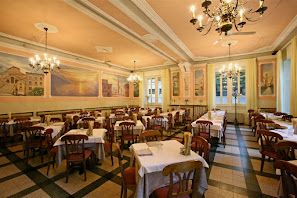A successful decade for crime novel set in Bergamo
Death in the High City, the first detective novel written in English to be set in Bergamo in northern Italy, was published ten years ago this summer.
To mark the tenth anniversary, East Wind Publishing have issued a new edition of the mystery with a front cover showing Bergamo’s Via Colleoni at night. The historic street in the Città Alta, Bergamo’s upper town, features as a key location in the novel.
Referred to as un romanzo giallo in Italian, Death in the High City centres on the investigation into the death of an English woman staying in Bergamo while working on a biography of the opera composer Gaetano Donizetti, who was born and died in the city.
The dead woman had been living in an apartment in Bergamo’s Città Alta and much of the action takes place within the walls of the upper town.
The novel was the first in a series to feature the characters of Kate Butler, a freelance journalist, and Steve Bartorelli, a retired Detective Chief Inspector, who is of partly Italian descent.
At first the local police do not believe there
is enough evidence to open a murder enquiry and so journalist Kate Butler, the
victim’s cousin, arrives in Bergamo to try to get some answers about her relative’s
death, on behalf of her elderly aunt, who is too frail to make the journey
herself.
She stays first at a hotel in the Città Bassa and then moves to a hotel in Bergamo’s historic Città Alta. Like the characters and events in the novel, the hotels are fictional, but the descriptions of them were inspired by the wonderful hospitality the author has experienced in Bergamo over the years.
Kate visits many of the places in Bergamo with
Donizetti connections and her enquiries also take her out to Lago d’Iseo and
into the countryside around San Pellegrino Terme.
The reader can enjoy Bergamo’s wonderful architecture and scenery from the comfort of their own armchair, while savouring the many descriptions in the novel of local food and wine.
After the novel was published, Author Val Culley was invited to present Death in the High City to an audience in San Pellegrino Terme in Lombardy, and sign copies of the book, as a guest at the fifth anniversary celebrations of Bergamo Su e Giù, a group of independent tour guides based in the city. During the evening, she was presented with a book about San Pellegrino Terme by the town’s mayor.
She also made two appearances on Bergamo TV to talk about the novel with presenter Teo Mangione during his daily breakfast programme. During one of her visits to the studios, she presented a copy of the book to the Mayor of Bergamo, Giorgio Gori, who took office the year the novel was published.
Val was invited to Bergamo for a further visit by the Cambridge Institute to give a talk about Death in The High City to a group of 80 Italian teachers of English and to sign copies for them.
She has also formally presented a copy of Death in the High City to the Biblioteca Civica (Civic Library), a beautiful 16th century building in white marble, designed by Vincenzo Scamozzi, situated in Piazza Vecchia, a location that features frequently in the novel.
She was later invited to give a talk about Death in the High City at a sixth form college in Zogno, a comune in Valle Brembana set in beautiful countryside in the hills above Bergamo.
Another highlight was when the New York Times mentioned to Death in the High City in a travel feature they were running about Bergamo.
The novel came out in Kindle format in May 2014 and a paperback version was released in July 2014. It has since sold copies in the UK, Italy, Spain, France, the Netherlands, Germany, America, Australia, Canada, and Mexico.
Death in the High City will interest readers
who enjoy the ‘cosy’ crime fiction genre, or like detective stories with an
Italian setting.

.jpg)















